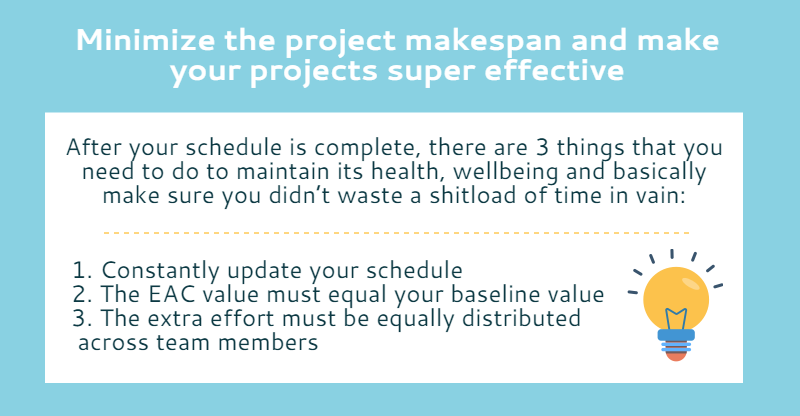In the world of project management, a project schedule is basically a list of activities, milestones and end deliverables that are needed to carry the project from start to finish, with their corresponding starting and ending dates.
A project schedule is a part of project planning and usually fits in the planning portfolio part of project management initiatives.
The good thing about project scheduling is that it allows to estimate the completion date of every activity, large and small, important or insignificant from start to finish. This ultimately allows PMs to plan into the future with maximum precision (assuming everything goes well) and understand the amount of workload that needs to be dealt with, how much time and money will be needed and how many people should be involved in a certain project.
The bad thing about scheduling is that it’s a pretty damn complex thing.
The thing is that in order for it to work, all the items mentioned in the description are often estimated by other stuff like resource allocation (sometimes for multiple projects), budget, task duration and linkages of task dependencies and their interrelations with other projects/tasks. (Yeah, when I first read this I was like “screw this shit” too, so don’t worry).
TL DR: Project schedule consists of various activities that depend of a bunch of other activities, which in turn, have interdependencies on other items. Inception anyone?
So on the upside, you have the opportunity to minimize the makespan of your projects and thus improve overall efficiency thanks to precise estimation, but on the downside, if you mess up (and there is a solid chance that you do), you’d wish you never considered this in the first place.
Not to worry though, there is always a way to make stuff work as intended.
Project scheduling and WBS
Project scheduling has a lot to do with WBS (work breakdown structure) so if you are planning on utilizing schedules in your projects, you better get the WBS done perfectly.
For those unfamiliar with WBS, it’s a kind of a map that visualizes every piece of work that needs to be done, in order to get the final deliverable. A good approach to WBS is getting the end deliverable at the top of your map and working backwards to the smallest tasks that need to be completed.
WBS is essential for project scheduling, mainly because it will get you the correct estimates of time, workforce and budget needed to complete all the tasks that form the end deliverable, which in turn, helps understand the task dependencies and their interrelations with each other.
The thing is that the schedule itself is an estimate, so the more you know about the other estimates that the schedule depends on, the better precision you will end up with in the end. Here is more about WBS and how to do it effectively.
How to create and maintain a healthy schedule
After you do your WBS and get each element in place, estimate the amount of time needed to perform each task, the amount of people involved as well as the budget needed for all of that, you can then create your schedule accordingly.
Depending on the number of dependencies that you have (or basically how complex your project is) you will need to be more careful, check and doublecheck everything you estimated during the WBS.
After your schedule is complete, there are three things that you need to do to maintain its health, wellbeing and basically make sure you didn’t waste a shitload of time in vain:

1. Constantly update your schedule – as time goes by and a number of tasks get complete, some problems/issues will unavoidably arise in the process that will jeopardize your base estimations one way or another, whether you like it or not. To make sure everything proceeds smoothly, you need to constantly update your schedule. The number of times you need to update it depends on the complexity of your project, but usually, once a week is good enough for most projects.
2. The EAC value must equal your baseline value – EAC stands for estimation at completion and basically refers to the forecasted value of the project when it is complete. Equaling the EAC and baseline values means that you have to coordinate your team in a way that won’t affect the value of the project when it was initially kicked off. So for example if you are behind on schedule after a few weeks of updates, it means that you will need to work extra hard to catch up. Otherwise, depending on the situation, you will receive (and deliver) less value to the client by the time the project is complete.
3. The extra effort must be equally distributed across team members (including vacations, day offs, and other similar stuff) – When you get to the stage where you need to push a few extra miles to catch up to the schedule, it’s important to distribute the extra work among team members equally, to avoid individual burnouts and messy situations (employees complaining that some of them have to work extra, while others don’t, etc.)
At the end of the day, you want to keep your schedule in line with the WBS, while making sure that the tasks somehow affected in the WBS don’t negatively affect your project schedule (if somebody messes up, it must not put you behind on schedule).
This is the whole idea behind the concept and when executed correctly, it can deliver a lot of value in terms of making projects effective and minimizing their makespan so that you can squeeze in another project or, choose to dedicate the extra time to various activities that will help you and your team relax and maintain sanity.
Business vector designed by Freepik
Follow us


